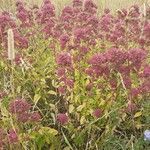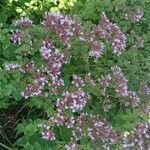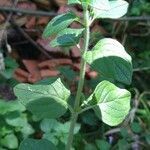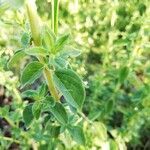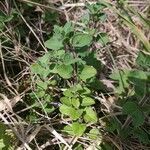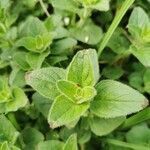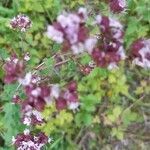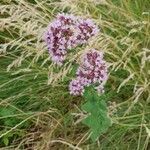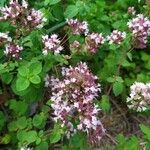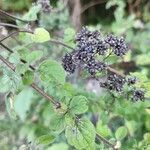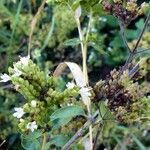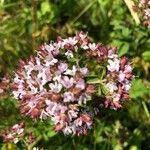| Therapeutic use
|
Jaundice (unspecified), Antifungal agents (aerial part), Antioxidants (aerial part), Fissure (apical part), Anti-inflammatory agents (apical part), Antitussive agents (apical part), Common cold (apical part), Hypersensitivity (apical part), General tonic for rejuvenation (apical part), Parasympatholytics (flower), Fissure (leaf), Anthelmintics (leaf), Anti-bacterial agents (leaf), Anti-inflammatory agents (leaf), Antineoplastic agents (leaf), Antioxidants (leaf), Antipyretics (leaf), Antirheumatic agents (leaf), Antitussive agents (leaf), Bites and stings (leaf), Bronchitis (leaf), Burns (leaf), Common cold (leaf), Diarrhea (leaf), Ear diseases (leaf), Earache (leaf), Eczema (leaf), Furunculosis (leaf), Hematologic diseases (leaf), Hypersensitivity (leaf), Influenza, human (leaf), Insecticides (leaf), Lice infestations (leaf), Lipid peroxidation (leaf), Liver diseases (leaf), Parasympatholytics (leaf), Skin diseases (leaf), Ulcer (leaf), Wound healing (leaf), Hair loss (rhizome), Analgesics (rhizome), Anticonvulsants (rhizome), Antihypertensive agents (rhizome), Antirheumatic agents (rhizome), Antitussive agents (rhizome), Bronchitis (rhizome), Cardiomyopathies (rhizome), Diarrhea (rhizome), Hysteria (rhizome), Parasympatholytics (rhizome), General tonic for rejuvenation (rhizome), Wound healing (rhizome), Hair loss (root), Analgesics (root), Anticonvulsants (root), Antihypertensive agents (root), Antipyretics (root), Antirheumatic agents (root), Antitussive agents (root), Bronchitis (root), Cardiomyopathies (root), Diarrhea (root), Diuretics (root), Dizziness (root), Hysteria (root), Parasympatholytics (root), General tonic for rejuvenation (root), Urinary tract infections (root), Wound healing (root), Antipyretics (shoot), Eczema (shoot), Furunculosis (shoot), Ulcer (shoot), Wound healing (shoot), Anti-inflammatory agents (stem), Antipyretics (stem), Antirheumatic agents (stem), Antitussive agents (stem), Bronchitis (stem), Ache(Ear) (unspecified), Alopecia (unspecified), Anodyne (unspecified), Bronchitis (unspecified), Cancer (unspecified), Carminative (unspecified), Catarrh (unspecified), Colic (unspecified), Decongestant (unspecified), Diaphoretic (unspecified), Diarrhea (unspecified), Emmenagogue (unspecified), Fever (unspecified), Flu (unspecified), Intestine (unspecified), Liniment (unspecified), Nausea (unspecified), Nervine (unspecified), Pectoral (unspecified), Pertussis (unspecified), Purgative (unspecified), Respiratory (unspecified), Rheumatism (unspecified), Sedative (unspecified), Skin (unspecified), Snuff (unspecified), Spice (unspecified), Stimulant (unspecified), Stomachic (unspecified), Stupefacient (unspecified), Sudorific (unspecified), Tea (unspecified), Tonic (unspecified), Toothache (unspecified), Tumor (unspecified), Wound (unspecified), Cold (unspecified), Rubefacient (unspecified), Digestive (unspecified), Diuretic (unspecified), / (unspecified), Spasm (unspecified), Itch (unspecified), Medicine (unspecified), Scrofula (unspecified), Tumor(Penis) (unspecified), Analgesics (unspecified), Anthelmintics (unspecified), Anti-inflammatory agents (unspecified), Antipyretics (unspecified), Antirheumatic agents (unspecified), Antitussive agents (unspecified), Common cold (unspecified), Contraceptive agents (unspecified), Earache (unspecified), Hypersensitivity (unspecified), Hysteria (unspecified), Influenza, human (unspecified), Insect repellents (unspecified), Laxatives (unspecified), Malaria (unspecified), Measles (unspecified), Menstruation disturbances (unspecified), Mouthwashes (unspecified), Parasympatholytics (unspecified), General tonic for rejuvenation (unspecified), Skin diseases (unspecified), Stomatitis (unspecified), Wound healing (unspecified), Analgesics (whole plant), Antirheumatic agents (whole plant), Bronchitis (whole plant), Colic (whole plant), Common cold (whole plant), Diarrhea (whole plant), Earache (whole plant), Hysteria (whole plant), Counterirritant (whole plant), Menstrual cycle (whole plant), Parasympatholytics (whole plant), General tonic for rejuvenation (whole plant), Toothache (whole plant), Whooping cough (whole plant), Wound healing (whole plant)
|
